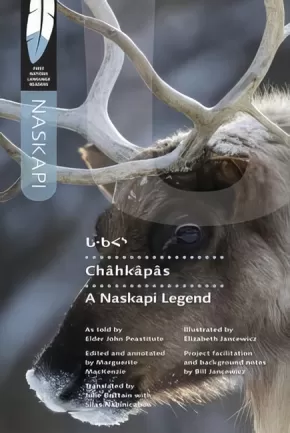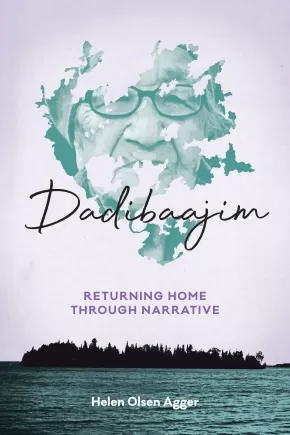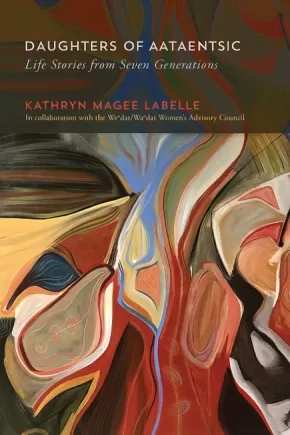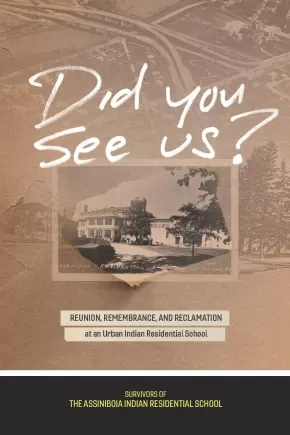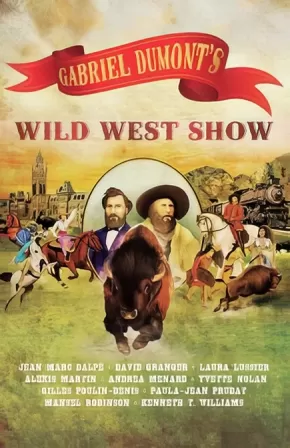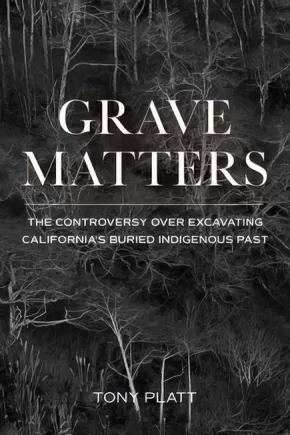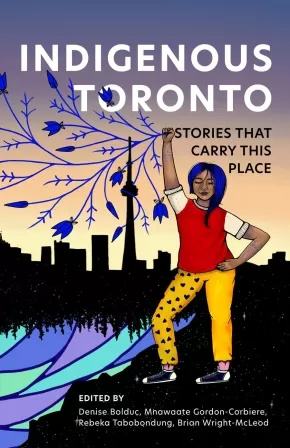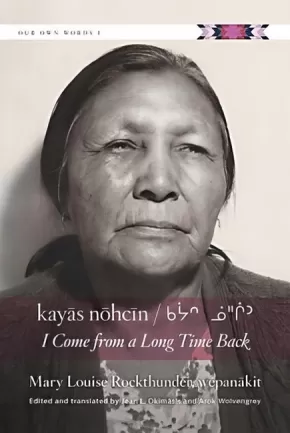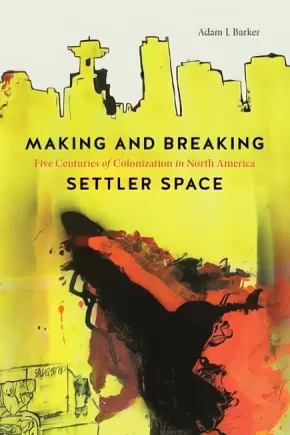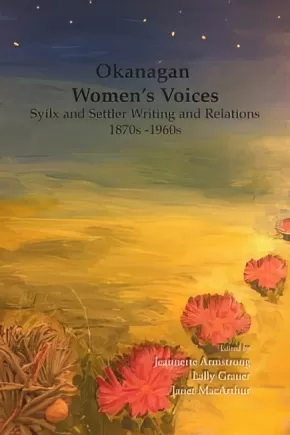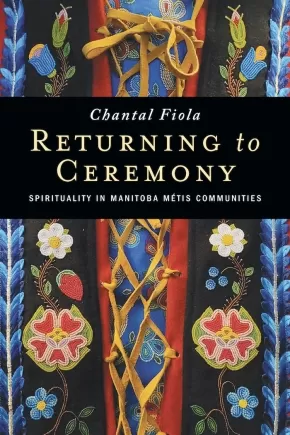History
Synopsis:
Châhkâpâs: A Naskapi Legend shares the story of Châhkâpâs, a heroic figure in First Nations storytelling, who performs feats of strength and skill in spite of his diminutive size.
The book shares this traditional legend as originally recorded in the Naskapi community in northern Quebec in 1967 when it was narrated by John Peastitute, a Naskapi Elder and accomplished storyteller. Transcribed in the Naskapi language and syllabic orthography, the book offers a literary resource for the Naskapi language community, and the English translation enables those unfamiliar with the language, or the story, to discover this important legend.
The book also contains extensive analysis of stories about Châhkâpâs, notes about the provenance of the recordings, a biography of the storyteller, and a history of the Naskapi people. Lavish illustrations from Elizabeth Jancewicz—an artist raised in the Naskapi community—provide a sensitive and accurate graphical account of the legend, which has also been approved by Naskapi speakers themselves.
Educator & Series Information
This book is part of the First Nation Language Readers series. With a mix of traditional and new stories, each First Nations Language Reader introduces an Indigenous language and demonstrates how each language is used today.
By John Peastitute
Edited by Marguerite MacKenzie
Translated by Julie Brittain and Silas Nabinicaboo
Illustrated by Elizabeth Jancewicz
Contributions by Bill Jancewicz
Additional Information
264 pages | 6.00" x 9.00" | Paperback
Synopsis:
For six decades, Olive Dickason was a remarkable contributor to Canadian public life. An award-winning journalist, influential academic, and respected human rights advocate, her life was a triumph over seemingly impossible obstacles. These many impediments include having a childhood marked by poverty; being forced, as a single working mother, to place her three daughters in foster care for several years; working as a female journalist in the sexist, “Mad Men” era of the 1950s and ‘60s; giving up a successful journalism career to obtain a doctorate in Indigenous history; arguing successfully with the university establishment on whether or not Indigenous peoples had history; and taking her fight against mandatory retirement all the way to the Supreme Court. Olive Dickason faced these challenges with determination and dignity and was an inspiration for all who knew her. Changing Canadian History: The Life and Works of Olive Patricia Dickason is the first full-length biography of this trailblazing icon who forever changed how Indigenous history is viewed in Canada.
Reviews
“Olive Dickason pushed the boundaries of sexism, racism, and ageism, defying colonial narratives upheld by patriarchal systems.”—Dr. Cindy Gaudet, Campus Saint-Jean, University of Alberta
“A biography of a brilliant woman who forged entry into Canadian cultural and intellectual institutions by sheer force of determination.”—Dr. Allyson Stevenson, Gabriel Dumont Institute Chair, Métis Studies
Educator Information
This book is the first biography of this trailblazing icon who forever changed how Indigenous history is viewed in Turtle Island and beyond. Based on years of meticulous research, this work provides readers with an engaging and thought-provoking read about this iconic academic who helped define a discipline.
Additional Information
445 Pages
Synopsis:
Dadibaajim narratives are of and from the land, born from experience and observation. Invoking this critical Anishinaabe methodology for teaching and learning, Helen Agger documents and reclaims the history, identity, and inherent entitlement of the Namegosibii Anishinaabeg to the care, use, and occupation of their Trout Lake homelands.
When Agger’s mother, Dedibaayaanimanook, was born in 1922, the community had limited contact with Euro-Canadian settlers and still lived throughout their territory according to seasonal migrations along agricultural, hunting, and fishing routes. By the 1940s, colonialism was in full swing: hydro development had resulted in major flooding of traditional territories, settlers had overrun Trout Lake for its resource, tourism, and recreational potential, and the Namegosibii Anishinaabe were forced out of their homelands in Treaty 3 territory, north-western Ontario.
Agger mines an archive of treaty paylists, census records, and the work of influential anthropologists like A.I. Hallowell, but the dadibaajim narratives of eight community members spanning three generations form the heart of this book. Dadibaajim provide the framework that fills in the silences and omissions of the colonial record. Embedded in Anishinaabe language and epistemology, they record how the people of Namegosibiing experienced the invasion of interlocking forces of colonialism and globalized neo-liberalism into their lives and upon their homelands. Ultimately, Dadibaajim is a message about how all humans may live well on the earth.
Reviews
“Dadibaajim is the product of a lifetime of reflection, and the distilled narrative we are presented shares an invaluable part of our Anishinaabe – and larger human – story that might have otherwise never been told. This work brings new value and appreciation for the role and positionality of our senior and traditional Elders, our Indigenous languages, and knowledge building customs and protocols that are inherent to the community." — Brian McInnes
"Dadibaajim is a fascinating story of the people and the land told from a uniquely Anishinaabe perspective. It also gives us hope for the future of these stories and traditions, particularly in the narratives, experiences, and perspectives of the younger generations that are represented." — Brian McInnes
“Dadibaajim is brilliant in its unapologetic incorporation of Anishinaabemowin and its prioritizing of Anishinaabe way of being in the world. It contributes to important decolonial work and challenges settler histories and discourse.” — Brittany Luby and Margaret Lehman
Educator Information
Table of Contents
Ch 1: How We Know
Ch 2: Subjectivity
Ch 3: As Written of Us
Ch 4: Our Anishinaabe Selves
Ch 5: Boreal Narratives
Ch 6: Colonial Identity
Ch 7: Anishinaabe Rectitude
Ch 8: Historical Texts
Additional Information
176 pages | 6.00" x 9.00" | Black and white illustrations and tables, maps, index, bibliography | Paperback
Synopsis:
In Daniels v. Canada the Supreme Court determined that Métis and non-status Indians were “Indians” under section 91(24) of the Constitution Act, 1867, one of a number of court victories that has powerfully shaped Métis relationships with the federal government.
However, the decision (and the case) continues to reverberate far beyond its immediate policy implications. Bringing together scholars and practitioners from a wide array of professional contexts, this volume demonstrates the power of Supreme Court of Canada cases to directly and indirectly shape our conversations about and conceptions of what Indigeneity is, what its boundaries are, and what Canadians believe Indigenous peoples are “owed.”
Attention to Daniels v. Canada’s variegated impacts also demonstrates the extent to which the power of the courts extend and refract far deeper and into a much wider array of social arenas than we often give them credit for. This volume demonstrates the importance of understanding “law” beyond its jurisprudential manifestations, but it also points to the central importance of respecting the power of court cases in how law is carried out in a liberal nation-state such as Canada.
Reviews
"This important collection of original pieces focusing on Daniel’s v. Canada and the Supreme Court’s decision will have an impact for years to come. Reader’s will appreciate the diverse areas of expertise found in this volume, including Indigenous leadership, political activism, sociology, law, and anthropology." — Christopher Adams
“Articulate, thoughtful, provocative assessments of how we might assess the Supreme Court’s 2016 decision regarding the Metis People’s legal status in Canada.” — William Craig Wicken
Educator Information
Other contributors: Tony Belcourt, Catherine Bell, Deborah A. Bolnick, Brenda L. Gunn, Arend J.A. Hoekstra, Thomas Isaac, Darryl Leroux, Jason Madden, Brenda Macdougall, Austin W. Reynolds, Rick W.A. Smith, Lauren Springs, D’Arcy Vermette
Table of Contents
Introduction
Ch. 1—Daniels in Context
Ch. 2—Harry Daniels and Section 91 (24) of the British North America Act
Ch. 3—After the Hysteria: Understanding Daniels v. Canada from a Métis Nation Perspective
Ch. 4—Daniels v Canada: A Framework for Redress
Ch. 5—The Other Declarations in Daniels: Fiduciary Obligations and the Duty to Negotiate
Ch. 4—Racism, Canadian Jurisprudence, and the de-Peopling of the Métis in Daniels
Ch. 5—Daniels Through an International Law Lens
Ch. 6—Daniels v. Canada Beyond Jurisprudential Interpretation: What to do Once the Horse has Left the Barn
Ch. 7—Outlining the Origins of “Eastern métis” Studies
Ch. 8—Making Kin in a Postgenomic World: Indigenous Belonging after the Genome
Ch. 9—How We Know Who We Are: Historical Literacy, Kinscapes, and Defining a People
Conclusion: The Multiple Lives of the Daniels Case
Additional Information
336 pages | 6.00" x 9.00" | index, bibliography
Synopsis:
Daughters of Aataentsic highlights and connects the unique lives of seven Wendat/Wandat women whose legacies are still felt today. Spanning the continent and the colonial borders of New France, British North America, Canada, and the United States, this book shows how Wendat people and place came together in Ontario, Quebec, Michigan, Ohio, Kansas, and Oklahoma, and how generations of activism became intimately tied with notions of family, community, motherwork, and legacy from the seventeenth to the twenty-first century. The lives of the seven women tell a story of individual and community triumph despite difficulties and great loss. Kathryn Magee Labelle aims to decolonize the historical discipline by researching with Indigenous people rather than researching on them. It is a collaborative effort, guided by an advisory council of eight Wendat/Wandat women, reflecting the needs and desires of community members. Daughters of Aataentsic challenges colonial interpretations by demonstrating the centrality of women, past and present, to Wendat/Wandat culture and history. Labelle draws from institutional archives and published works, as well as from oral histories and private collections. Breaking new ground in both historical narratives and community-guided research in North America, Daughters of Aataentsic offers an alternative narrative by considering the ways in which individual Wendat/Wandat women resisted colonialism, preserved their culture, and acted as matriarchs.
Reviews
"Daughters of Aataentsic makes a significant contribution to the historiography of Indigenous women. Labelle has written an important book and her laudatory and exemplary methodology is a model for all people researching and writing on First Nations and Native Americans." — Clifford Trafzer, University of California, Riverside
"Daughters of Aataentsic enriches our understanding of the everyday lives of real women, their families, and communities across time in Quebec and parts of the southwestern and western United States. This book does not denounce the past, holler, and shout, but rather attends to the range of information and knowledge passed down to draw us into times and places we would otherwise not have the privilege of knowing from an Indigenous perspective. Its insights have stuck with me long after my first reading, as I expect they will for others." — Jean Barman, University of British Columbia
Educator Information
Table of Contents
Acknowledgments xiii
Figures xv
Map xxvi
Introduction 3
1 Cécile Gannendâris (?-1669) 13
2 Marie Catherine Jean dit Vien (1676-1767) 33
3 Margaret Grey Eyes Solomon (1816-1890) 50
4 Mary McKee (1838-1922) 69
5 Eliza Burton Conley Jr (1869-1946) 90
6 Jane Zane Gordon (1871-1963) 115
7 Dr Éléonore Sioui (1924-2006) 132
Epilogue: The Wendat/Wandat Women’s Advisory Council 154
Notes 169
Index 205
Recommended for these subjects: History, Women's History, North American History, Canadian History, Indigenous History, Indigenous Studies, Women's and Gender Studies.
Additional Information
240 pages | 6.00" x 9.00" | 21 Photos, 7 Diagrams
Synopsis:
The Assiniboia school is unique within Canada’s Indian Residential School system. It was the first residential high school in Manitoba and one of the only residential schools in Canada to be located in a large urban setting. Operating between 1958 and 1973 in a period when the residential school system was in decline, it produced several future leaders, artists, educators, knowledge keepers, and other notable figures. It was in many ways an experiment within the broader destructive framework of Canadian residential schools.
Stitching together memories of arrival at, day-to-day life within, and departure from the school with a socio-historical reconstruction of the school and its position in both Winnipeg and the larger residential school system, Did You See Us? offers a glimpse of Assiniboia that is not available in the archival records. It connects readers with a specific residential school and illustrates that residential schools were often complex spaces where forced assimilation and Indigenous resilience co-existed.
These recollections of Assiniboia at times diverge, but together exhibit Survivor resilience and the strength of the relationships that bond them to this day. The volume captures the troubled history of residential schools. At the same time, it invites the reader to join in a reunion of sorts, entered into through memories and images of students, staff, and neighbours. It is a gathering of diverse knowledges juxtaposed to communicate the complexity of the residential school experience.
Reviews
“Remembering Assiniboia is a thoughtful, community based project rooted in the needs of the Assiniboia Residential School community. This book is a must read for those working on the history of Residential Schools and those engaged in community based restorative justice projects.” — Krista McCracken
"Did You See Us? was born out of a reunion, and readers are invited to the reverberations of this coming together. It offers multi-vocal perspectives primarily from survivors but also from non-Indigenous staff, archival documents, and settler community members. As the Truth and Reconciliation Commission begins to accumulate anniversaries, now more than ever the testimonies of residential school survivors are much needed." — Jane Griffith
Educator Information
Table of Contents
Dedication
Land Acknowledgement Statement/ Theodore Fontaine
Preface / Theodore Fontaine
Section One: The Residential Years (1958-1967)
Section Two: The Hostel Years (1967-1973)
Section Three: Assiniboia and the Archives
Section Four: Staff Remembrances
Section Five: Neighbours
Section Six: Winnipeg Remembers
Section Seven: Reunion and Remembrance
Additional Information
272 pages | 6.00" x 8.50" | bibliography
Synopsis:
Gabriel Dumont’s Wild West Show is a flamboyant epic, constructed as a series of tableaux, about the struggles of the Métis in the Canadian West. It is a multilayered and entertaining saga with a rodeo vibe, loosely based on Buffalo Bill’s legendary outdoor travelling show. In 1885, following the hanging of his friend Louis Riel, bison hunter Gabriel Dumont fled to the United States. There he was recruited by the legendary Buffalo Bill, founder of Buffalo Bill’s Wild West, a gigantic outdoor travelling show that re-enacted life in the American West. It made a huge impression on Dumont, and he dreamed of putting together a similar show to tell the story of the struggle of Canada’s Métis to reclaim their rights.
The creative team behind Gabriel Dumont’s Wild West Show – including ten authors, Indigenous and non-Indigenous, French- and English-speaking men and women – brings Dumont’s dream to life in a captivating, joyously anachronistic saga. The theatrical version of Gabriel Dumont’s Wild West Show presented by the National Arts Centre was one of a number of exceptional projects funded through the Canada Council for the Arts’ New Chapter initiative. (Adapted from nac-cna.ca/en/wildwestshow).
This is a bilingual book, co-published with Éditions Prise de parole, and enhanced with a historical background, a chronology of the Métis Resistances, and visual documents.
Reviews
“Really excellent. I laughed till I cried!” —Marilou Lamontagne, ICI Radio-Canada Ottawa-Gatineau
“[A] play that pleases, puzzles, and provokes, in a form that keeps shifting wildly from one moment to the next like a bucking bronco.”—J. Kelly Nestruck, Globe and Mail
“If Gabriel Dumont’s Wild West Show is so successful, while being funny and sad at the same time, it’s because the creative team did its research and listened to the communities involved in the rehabilitating of the figure of Gabriel Dumont. What takes shape here is a wave of madness and a rewriting of our national narrative.”—Maud Cucchi, JEU Revue de théâtre
“Gabriel Dumont’s Wild West Show is a crazed, fast-paced Métis 101 history lesson, in which acidity and humour deliver the story.”—Martin Vanasse, Radio-Canada
“[A] seamlessly cohesive narrative ... a zany form ... a phantasmagorical piece of pure entertainment ... a delirious blend of historical drama, musical, burlesque cabaret, hockey night, and TV quiz!”—Pierre-Alexandre Buisson
“Between bursts of laughter (of the uneasy sort at times) and moments of lively emotion, Gabriel Dumont’s Wild West Show takes [us] on a journey up hill and down dale through the history of the Métis Resistances and tells an oft-forgotten part of our collective history.” - Valérie Lessard, Le Droit
Additional Information
304 pages | 5.40" x 8.50" | Paperback
Synopsis:
How do we reconcile the sanctity of Indigenous burial grounds with the desire to study them?
Whether by curious Boy Scouts and “backyard archaeologists” or competitive collectors and knowledge-hungry anthropologists, the excavation of Native remains is a practice fraught with injustice and simmering resentments.
Grave Matters is the history of the treatment of Native remains in California and the story of the complicated relationship between researcher and researched. Tony Platt begins his journey with his son’s funeral at Big Lagoon, a seaside village in pastoral Humboldt County in Northern California, once O-pyúweg, a bustling center for the Yurok and the site of a plundered native cemetery. Platt travels the globe in search of the answer to the question: How do we reconcile a place of extraordinary beauty with its horrific past?
Grave Matters centers the Yurok people and the eventual movement to repatriate remains and reclaim ancient rights, but it is also a universal story of coming to terms with the painful legacy of a sorrowful past. This book, originally published in 2011, is updated here with a preface by the author.
Reviews
“A new edition on the tenth anniversary of Tony Platt's extraordinary work, Grave Matters, could not come at a more important moment when the precariousness of the planet itself recalls the genocide unleashed by European and Euroamerican colonialism that endures and continues to haunt descendants of the perpetrators, many of whom engage in ghoulish thefts of the remains of the dead. In his own grieving for a lost son, Platt enters a circle of grieving in the Yurok nation, becoming a powerful voice for decolonization and the protection of Indigenous grave sites.” —Roxanne Dunbar-Ortiz, author of An Indigenous Peoples' History of the United States
Additional Information
256 pages | 6.00" x 9.00" | Paperback
● Mnawaate Gordon-Corbiere (Indigenous Canadian; First Nations; Anishinaabeg; Ojibway; M'Chigeeng First Nation;)
● Rebeka Tabobondung (Indigenous Canadian; First Nations; Anishinaabeg; Wasauksing First Nation;)
Synopsis:
A collection of perspectives by and about Indigenous Toronto, past, present, and future.
Beneath every major city in North America lies a deep and rich Indigenous history that has been colonized, paved over, and ignored. Few of its current inhabitants know that Toronto has seen 12,000 years of different peoples, including the Haudenosaunee, the Anishinaabe, the Huron-Wendat, and the Mississaugas of the New Credit, and a vibrant culture and history that thrives to this day.
With original contributions by Indigenous elders, scholars, journalists, artists, activists, and historians about art, food, health, and more, this unique anthology explores the poles of erasure and cultural continuity that have come to define a crossroads city-region that was known as a meeting place long before the arrival of European settlers.
Contributors include political scientist Hayden King, historian Alan Corbiere, musician Elaine Bomberry, artist Duke Redbird, playwright Drew Hayden Taylor, educator Kerry Potts, writer/journalist Paul Seesequasis and former Mississaugas of the New Credit chief Carolyn King.
Additional Information
192 pages | 5.50" x 8.50"
Synopsis:
A collection of narratives as told in the nêhiyawêwin (Cree) language by Elder Mary Louise Rockthunder, spanning her rich life and extensive knowledge of her traditions and culture.
Mary Louise (née Bangs) Rockthunder, wêpanâkit, was an Elder of Cree, Saulteaux, and Nakoda descent. Born in 1913, raised and married at nēhiyawipwātināhk / Piapot First Nation, Mary Louise, a much-loved storyteller, speaks of her memories, stories, and knowledge, revealing her personal humility and her deep love and respect for her family and her nêhiyawêwin language and culture.
The recordings that are transcribed, edited, and translated for this book are presented in three forms: Cree syllabics, standard roman orthography (SRO) for Cree, and English. A full Cree-English glossary concludes the book, providing an additional resource for those learning the nêhiyawêwin language.
Educator & Series Information
This book is part of the Our Own Words series. Our Own Words is a new Indigenous language series that seeks to present longer, more extensive Indigenous texts for both intermediate and advanced learners of the language.
Additional Information
264 pages | 6.00" x 9.00" | Translated by Jean L. Okimasis and Arok Wolvengrey | Paperback
Synopsis:
Five hundred years. A vast geography. And an unfinished project to remake the world to match the desires of settler colonizers. How have settlers used violence and narrative to transform Turtle Island into what is currently called North America? What does that say about our social systems, and what happens next?
Deploying analytical tools from diverse disciplines, and drawing on sources ranging from archives to pop culture and personal experience, Making and Breaking Settler Space addresses pressing questions left by the complex and obscured process of colonization. Adam Barker articulates a dynamic analytical model to explain how settler spaces have developed and continue to evolve. He traces the trajectory of settler colonialism, drawing out details of its operation from the imperial colonization of Turtle Island in the 1500s to contemporary contexts that include problematic activist practices by would-be settler allies.
Making and Breaking Settler Space proposes an innovative, unified spatial theory of settler colonization in Canada and the United States. In the process, it uncovers systemic weaknesses that can inform the decolonization efforts of resurgent Indigenous nations and settler activists alike, and argues for relationships founded on solidarity and shared acknowledgment that the settler project is a failed one.
This thought-provoking work will be of great use not only to scholars and students of settler colonialism but also to activists and political commentators concerned with Indigenous people’s future beyond the settler colonial society.
Reviews
“Making and Breaking Settler Space offers a comprehensive analysis of the colonial spatialities inherent to the settler state. It is an innovative interpretation of the affective dimensions of settler colonialism, from its obsessive drive for ownership, control, and transcendence to the possibilities that come from failing to meet these expectations.”— Soren Larsen, University of Missouri
Educator Information
Table of Contents
Introduction
1 Cores and Peripheries: From Imperial Contact to Settler Colonial Claims
2 Spatialities of Settlement: Remaking Landscapes and Identities
3 Remaking People and Places: States, Suburbs, and Forms of Settlement
4 Revolutionary Aspirations? Social Movements and Settler Colonial Complicity
5 The Efficacy of Failure: Advancing Struggles in Support of Indigenous Resurgence
6 Affinity and Alliance: Breaking the Boundaries of Settler Colonial Space
Notes; References; Index
Additional Information
312 pages | 6.00" x 9.00" | 2 photographs, 7 diagrams, 1 map | Hardcover
Synopsis:
The writing and relations between Syilx women and settler women, largely of European descent, who came to inhabit the British Columbia southern interior from the mid-nineteenth to the early twentieth centuries.
Educator Information
Okanagan Women’s Voices features the writing and stories of seven women: Susan Moir Allison (1845-1937), Josephine Shuttleworth (1866-1950), Eliza Jane Swalwell (1868-1944), Marie Houghton Brent (1870-1968), Hester Emily White (1877-1963), Mourning Dove (1886-1936) and Isabel Christie MacNaughton (1915-2003).
Additional Information
6.00" x 9.00" | Paperback
Synopsis:
The exhaustive, definitive history and stories of the Cega‘ K´i na Nakoda Oyáté (Carry The Kettle Nakoda First Nation), told by the people themselves.
Born out of a meticulous, well-researched historical and current traditional land-use study led by Cega̔ K´iɳna Nakoda Oyáté (Carry the Kettle Nakoda First Nation), Owóknage is the first book to tell the definitive, comprehensive story of the Nakoda people (formerly known as the Assiniboine), in their own words. From pre-contact to current-day life, from thriving on the Great Plains to forced removal from their traditional, sacred lands in the Cypress Hills via a Canadian “Trail of Tears” starvation march to where they now currently reside south of Sintaluta, Saskatchewan, this is their story of resilience and resurgence.
Educator Information
Based on a comprehensive traditional and current land-use study and history of the Carry The Kettle First Nation, combining oral history from Nation Elders and historical/anthropological research.
The destruction of the bison on the Canadian plains, disease, and Canada’s various damaging colonial policies brought profound changes and hardships to the Nakoda; this book chronicles the changes they faced and illustrates their endurance throughout history.
Most of the victims of the Cypress Hill Massacre were ancestors of the Carry The Kettle Nakoda First Nation, and many were forced out of their traditional lands on a Canadian Trail of Tears in 1882–83.
Additional Information
412 pages | 6.00" x 9.00" | Paperback
Synopsis:
Red Nation Rising is the first book ever to investigate and explain the violent dynamics of bordertowns. Bordertowns are white-dominated towns and cities that operate according to the same political and spatial logics as all other American towns and cities. The difference is that these settlements get their name from their location at the borders of current-day reservation boundaries, which separate the territory of sovereign Native nations from lands claimed by the United States.
Bordertowns came into existence when the first US military forts and trading posts were strategically placed along expanding imperial frontiers to extinguish indigenous resistance and incorporate captured indigenous territories into the burgeoning nation-state. To this day, the US settler state continues to wage violence on Native life and land in these spaces out of desperation to eliminate the threat of Native presence and complete its vision of national consolidation “from sea to shining sea.” This explains why some of the most important Native-led rebellions in US history originated in bordertowns and why they are zones of ongoing confrontation between Native nations and their colonial occupier, the United States.
Despite this rich and important history of political and material struggle, little has been written about bordertowns. Red Nation Rising marks the first effort to tell these entangled histories and inspire a new generation of Native freedom fighters to return to bordertowns as key front lines in the long struggle for Native liberation from US colonial control. This book is a manual for navigating the extreme violence that Native people experience in reservation bordertowns and a manifesto for indigenous liberation that builds on long traditions of Native resistance to bordertown violence.
Reviews
“The authors of this brilliant exposition on bordertown violence are no ordinary academics, although academia would benefit from having more faculty scholars such as these. They are also master organizers, a part of a network of indigenous and other community organizers in Indian Country fueling the process of decolonization of Native lands and communities. Bordertown violence is as old as US colonization of the continent itself, and it persists today in the towns and cities that border Native reservations and communities all over US-claimed territory and is replicated in even more distant cities that have large Native populations, many of whom are homeless. This may be the most important organizing manual ever produced by a social movement in the United States.”—Roxanne Dunbar-Ortiz, author of An Indigenous Peoples’ History of the United States
“The borders racking our world are in constant motion and, like the explosive grinding of tectonic plates, the violence of this movement and resistance to it emerges most sharply at the edges. This essential volume brings together militant intellectuals to provide an accessible introduction to the violent encirclement of indigenous communities, and to provide crucial concept-weapons to deepen ongoing collective resistance.” —George Ciccariello-Maher, author of Decolonizing Dialectics
“A remarkable body of work that effectively weaves long overdue native scholarship and historical analysis of settler colonialism with direct and timely frontline reports on the continuing bordertown wars and conflicts in occupied native territories. Offers a comprehensive framework for advancing present and future indigenous resistance and liberation struggles.”—John Redhouse (Diné)
Additional Information
176 pages | 6.00" x 9.00" | Paperback
Synopsis:
Returning to Ceremony is the follow-up to Chantal Fiola’s award-winning Rekindling the Sacred Fire and continues her ground-breaking examination of Métis spirituality, debunking stereotypes such as “all Métis people are Catholic,” and “Métis people do not go to ceremonies.” Fiola finds that, among the Métis, spirituality exists on a continuum of Indigenous and Christian traditions, and that Métis spirituality includes ceremonies. For some Métis, it is a historical continuation of the relationships their ancestral communities have had with ceremonies since time immemorial, and for others, it is a homecoming—a return to ceremony after some time away.
Fiola employs a Métis-specific and community-centred methodology to gather evidence from archives, priests’ correspondence, oral history, storytelling, and literature. With assistance from six Métis community researchers, Fiola listened to stories and experiences shared by thirty-two Métis from six Manitoba Métis communities that are at the heart of this book. They offer insight into their families’ relationships with land, community, culture, and religion, including factors that inhibit or nurture connection to ceremonies such as sweat lodge, Sundance, and the Midewiwin. Valuable profiles emerge for six historic Red River Métis communities (Duck Bay, Camperville, St Laurent, St François-Xavier, Ste Anne, and Lorette), providing a clearer understanding of identity, culture, and spirituality that uphold Métis Nation sovereignty.
Reviews
"Grounded in the communities of her home territory, Chantal Fiola brings critical insider knowledge, insight and analysis to the topic of Metis spirituality. The combination of historical background with contemporary voice offers an understanding of the Metis spirit that will nurture the nation and enlighten the broader public." — Kim Anderson
“Returning to Ceremony is a courageous book given the tensions surrounding religious affiliation in the Metis community. It is a challenging topic that has been dealt with sensitively, with balance and candour."— Blair Stonechild
Ch 1: Métis Spirituality: Confronting Stereotypes
Ch 2: Searching for Our Stories in Oral History
Ch 3: Combing the Written Record for Our Stories
Ch 4: A Métis-Centred Study and Approach
Ch 5: Six Red River Métis Communities
Ch 6: Meeting the Participants
Ch 7: Métis Family Relationships with Land, Language, and Identity
Ch 8: Métis Family Relationships with Culture and Religion
Ch 9: Exploring Self-Identification
Ch 10: Spirituality, Types of Ceremonies, and Disconnection Factors
Ch 11: Connection Factors, Impacts upon Identity, and Others’ Reactions
Ch 12: Métis Spirituality Today
Additional Information
272 pages | 6.00" x 9.00" | Index, Bibliography | Paperback

